Yearly Archives: 2022
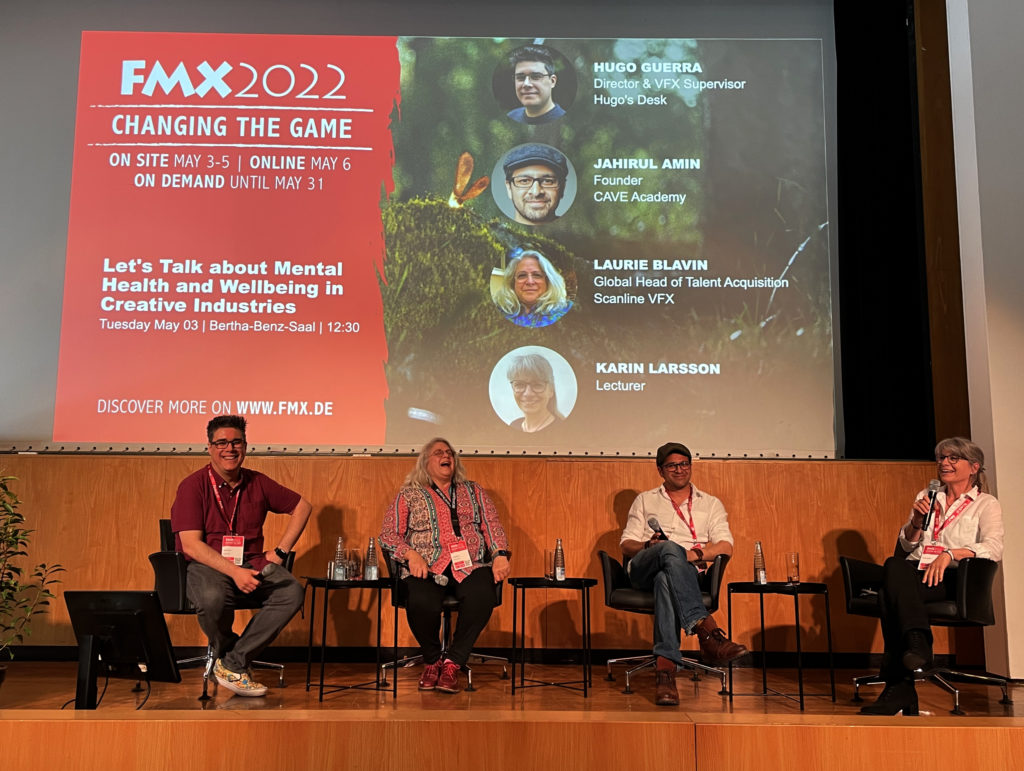
I am sorry: It is a long read.
Sometimes there are panels that are so important that no one notices. They are life-saving. This panel from the Social Impact Category called „Lets talk about Mental Health and Wellbeing in Creative Industries“ is just such a panel.
Hugo Guerra (Hugo’s Desk), Laurie Blavin (Scanline VFX), Karin Larsson, Lecturer and Jahirul Amin (CAVE Academy) talk about the long-tolerated problems of employees in the creative industries
The four speakers know their stuff.
Laurie Blavin as Global Head of Talent Acquisition of 1300 employees. A huge business with locations all over the world. Hugo Guerra. His filmography is so long that the author gets bored just scrolling down his portfolio on the website. He has been everywhere. At The Mill, Fire Without Smoke, Sony Playstation or Rebellion Games. Jahirul Amin. He is founder of CAVE Academy, which specialises in VFX, animation and games training for the creative industry. Before launching CAVE Academy, he was the VFX Trainer at DNEG London, and before that, a lecturer in Computer Animation at Bournemouth University. Karin Larson has a PhD in psychology and has worked in the USA for many years. She is a lecturer at the Filmakademie Baden-Württemberg in Ludwigsburg and covers the topics how to build a successful team, solve problems in team situations and be able to enjoy a productive team. She specialises in the needs of employees in the creative industries.
All four of them know what they are talking about and illuminate the topic from many angles, be it from the point of view of the people concerned to that of the psychologists.
Questions are asked such as „How can you stand working in this industry? This stress, the hard deadlines, the long hours, the working conditions and sometimes environments?“
Most people can’t take it. Concentration problems, health problems of too much sitting, the long hours where you have to be awake all the time. When you’re young you put up with it, but not so when you’re older.
People get sick, they lose themselves in work, they don’t find an end, they work more and more and finally they don’t know who they are, what they can do, what they used to be and what they want to be. They work, let themselves be driven by deadlines and demands until they simply collapse. It is an industry comparable to slave labour. 16 hours is no problem, so is weekend work, last minute time changes, nights without sleep at the computer and sleepless nights because you can’t switch off anymore.
How is it that an industry can provoke such reactions in its employees? Surely it is because of the glamorous side of this world. People work for the film industry. There are stars to be found there. Stars in every trade, be it cinematographers, actors, special effects artists, sound artists, costume etc. dreams are built here and it is from the fascination of the never before seen, lived, thought and dreamed that the creative industries thrive. They provide the food to break out of reality, to do a bit of escapism. Whoever plays in this industry is part of this entertainment machinery, full of artists and deviant professions and specialists. It’s like a secret industry, because most people don’t even understand what the titles and work units do and mean.
That’s why myths can be played with. At the conferences, young people stand on a podium and tell how they designed and produced this or that character. What it took to make a lifelike virtual character with wings, fur made of water particles or streams of fire or other fantastic attributes.
They talk about joints, rigging, how many studies were needed, which templates were necessary for motion tracking and what was thought of and done to integrate the light on the surface of a completely virtual art character into a real film scene. It’s a pleasure to listen.
You want to be fooled too much and become a part of it. One also wants to tell about the fact that one has made a tremendous effort, that one has not failed at problems, but that all of them have been solved. That the result yielded an OSCAR or an EMMY Award, that one had a part in such a production and appears in the credits. Fame and glory, unfortunately not enough money and time. It’s a kind of secret society. And as it is with such societies, many other aspects remain in the dark.
And so it is that it is almost a „badge of honour“ in the industry to have a burn out. The fact that burn-out is a serious mental illness that those affected carry with them throughout their lives and always have to deal with is not addressed. „That should not be the case. You have to keep your creativity alive, and that only works if you are healthy. So please: get away from the screen“. (Laurie Balvin)
The poor pay, the pressure to hand over creative work in bulk, to have the good idea, to be able to realise it accordingly with the manifold tools, to always have a solution ready. Perhaps it is the fear of not being noticed by the creative director or of receiving a crushing critique from the art director, only to be demoted as a consequence. (Hugo Guerra)
It is the dichotomy of wanting to go home after 8 hours of hard and concentrated work, to enjoy a private life. But that’s not easy, because all the other colleagues are still at their desks and computers. You don’t want to leave anyone behind, you don’t want to set boundaries. These industries exploit and the creatives let themselves be exploited. The young creatives go to the limit of their pain. They don’t have enough self-confidence yet to stand up for themselves. (Jahirul Amin)
In addition, there is often the family saga of the company. The workers are told that they are one big family. Families share pain and joy. People are there for each other. But is that true? Agencies, companies want to, have to make turnover. The family story is used against the employees like in mafia structures. Either you are one of us, or you are against us.
There are a lot of circumstances that lead to employees giving up on themselves. And realise far too late that they no longer have any friends, that they don’t do any sport, that they eat badly, maybe even develop moderate illnesses due to bad posture after 17 hours of sitting and staring at the computer, that they wake up in the middle of the night thinking about work, that they have no motivation, that they only want to be at work. Because that is where they always are, where they are at home. People forget what it means to clear their heads, maybe to read, or to go for a walk. Or even join a sports club, raise a family, visit friends and pop in for a coffee or tea without pressure. To experience time. Or to enjoy boredom.
The panel deals with this problem.
Karin Larsson tells us that a position has been created in the productions of the film academy that deals with the welfare of the participants. An astonishing statement in the eyes of the author. Almost unimaginable, in fact. She reports that the artists are reminded to sleep, take breaks, get air, eat and experience community. Is it not
unfortunate that we are in a world of work where one has to be reminded of such fundamental needs?
Yes it is. It is perhaps due to the nature of the artistic profession. Intrinsic motivation drives action, it’s no longer mainly about money, a big company car or the bonuses. It’s about art, culture, the greater good. That drives employees and that is very fertile ground for exploitation.
In this panel, all that is spoken and named. What has a name gets a face. There are ways out. There are already support organisations such as Health and well-being resources in the visual effects Industry. In webinars, the silverbacks talk about their experiences in the creative industries, how they coped with the problems, what solutions they developed.
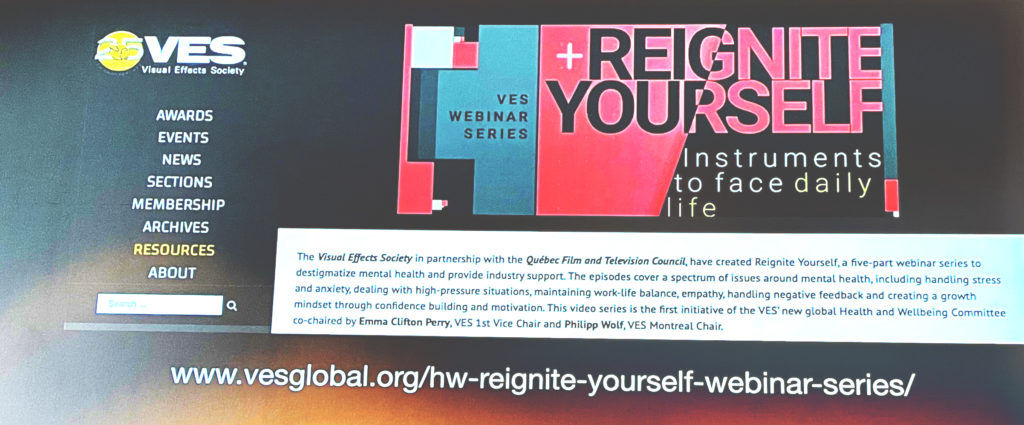
www.vesglobal.org/hw-reignite-yoursself-webinar-serien/
Hugo Guerra: „It was great to work 16 hours and more. You were even admired and praised for it. At the same time, you feel like a working robot. Physical, mental and psychological problems are simply pushed away. Is it good to sleep so little? Isn’t it cool to work as much as possible?“
Young women artists are finally being told that this kind of work mentality is not to be supported. It is being talked about at all. This panel creates an awareness. Creates a community.
The audience hears that their work is worth a lot. That the industries are scrambling to find people. (Why is this hand-wringing, I wonder? Author’s note: because the working conditions and wages are so horrendous maybe?)
It is said that social media contributes a lot to the fact that artists see themselves as individual cases. It is no longer seen that many people in the creative industries have similar experiences. That it is good to form communities and not to strive for likes. Not to scroll up and down somewhere, only to experience later that everything but relaxation and recreation has been achieved? That time is gone, escapism works. Brave new world.
We are there! Now let’s change it. Thank you for this panel.
Post by Prof. Ursula Drees
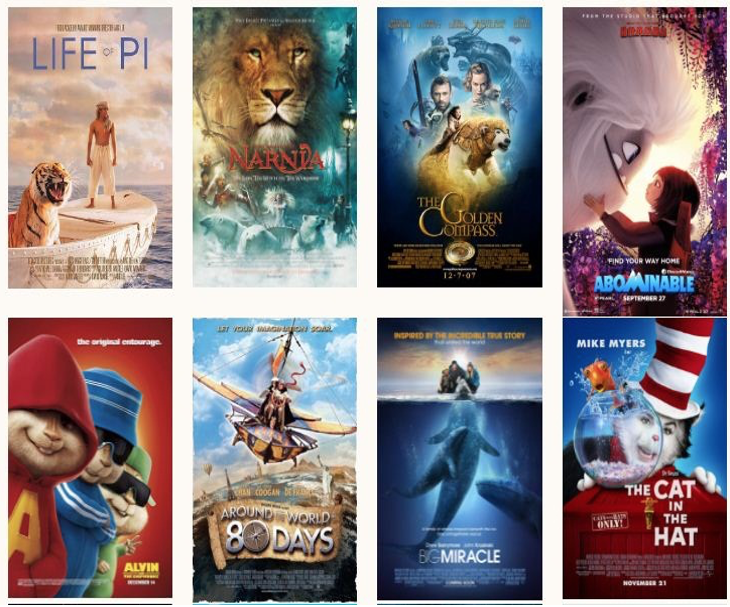
Saraswathi ‘Vani’ Balgam is an Indian born writer, director, self-taught photographer and filmmaker. Her Indian and Southeast Asian cultural heritage, along with her experiences and memories from being an avid global traveller, help her to portray common humanity and unique journeys within her characters and stories.
Her exposure to the film industry started from a young age when her father started a 2D animation studio within their family home, with an aim to create films which involved rich Indian culture and heritage for a global audience. This foundation of creativity from her father, as well as her mother who is also vividly creative.
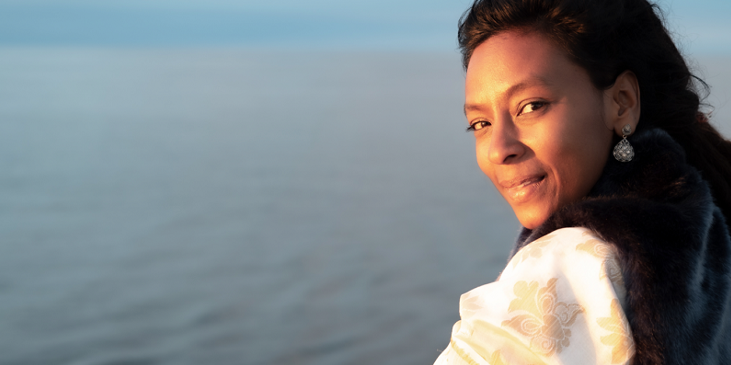
While Vani started her career as a business development executive for CMM Studios Limited in Mumbai, India, she slowly rose through the ranks within the Southeast Asian film scene, and was appointed as Executive Director and Founder of the Rhythm and Hues Asian Studios. While executive director, she managed employees across four studios in Kuala Lumpur, Mumbai, Hyderabad, and Taiwan which produced VFX for many major Hollywood films, such as ‘Life of Pi’, and ‘The Golden Compass’, which each won Rhythm and Hues Studios the Academy Awards for Best VFX in 2013 and 2008 respectively. Vani also served as the Head of Creative Management and Training for Dreamworks Studios in Shanghai, China.
Saraswathi Balgam founded Dancing Atoms Studio to create amazing stories with unforgettable and different characters. Vani encouraged other writers, directors, producers to create animation and direct animated VFX content since India has a lot of them stories to tell for audiences worldwide. Dancing Atoms has championed the Women Creators – Epic games Unreal programme.
In 2021 Vani wrote, directed and produced ‘Arising’. She tells the story of a young woman who has experienced sexual abuse in her workplace fights back with the help from her sisters and the #MeToo movement. The film was documented with footage of the LA women’s march in January 2018. This project was selected in the ‘Women’s International Film Festival Nigeria’ in 2022.
We are delighted to be interviewing her on Wednesday, May4th at FMX, immediately after her talk. This video post will be published a little later. For now, we’re diving headfirst into the FMX.
Post written by Luiza Noemi Bogya, Karen Reilly, Miklos Bajus
Monets Garten – Alegria goes Kunstausstellung!
Gemeinsam mit der Schweizer „Immersive Art AG” wird die Ausstellung „Monets Garten”, eine 360-Grad Erlebnisreise durch die Geschichte und Werke eines der größten Künstler des vergangenen Jahrhunderts präsentiert. (Quelle Facebook Ankündigung der Ausstellung).
Das immersive Kunsterlebnis wurde bis Mitte März in Berlin in den Räumen der Alten Münze gezeigt.
Es werden im Stile des Ateliers de Lumiere raumgreifende Illuminationen und Bespielungen angekündigt.
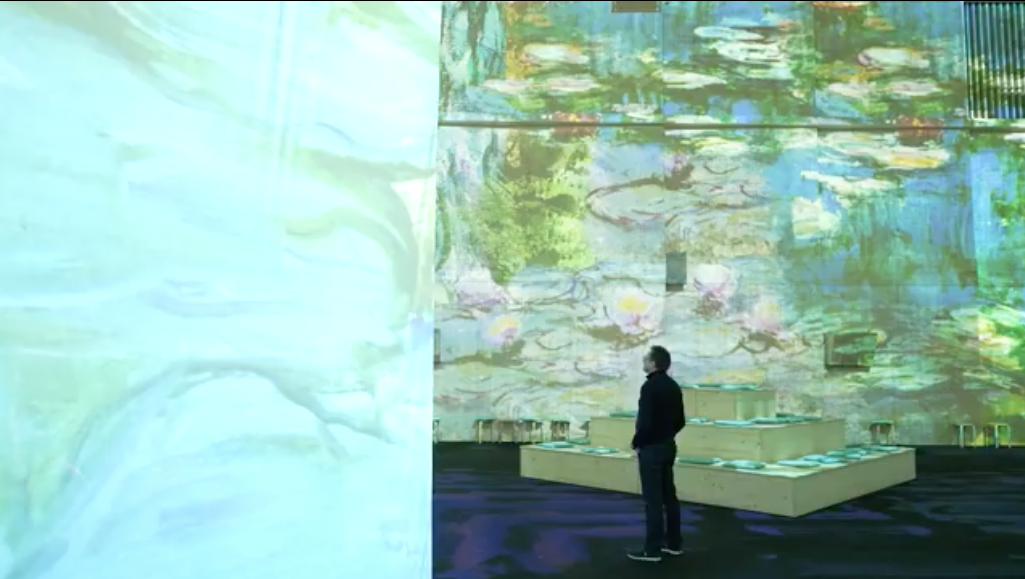
Die Besucher*innen sollen in die Kunstwerke eingetaucht werden. Diese Art der Kunstvermittlung ist zur Zeit sehr en vogue. Es ist scheinbar faszinierend in Projektionsräume zu treten, wo der Boden, die Decke und die Wände bespielt werden. Wenn der Ton und die Animationen stimmen, dann soll es immersiv werden. Immersivität bedeutet, dass die Zuschauer*innen ihre Ich-Verortung in einem realen Raum für eine gewisse Zeit aufgeben und ganz in einem artifiziell erzeugten Raum eintauchen und das Dortige erleben.
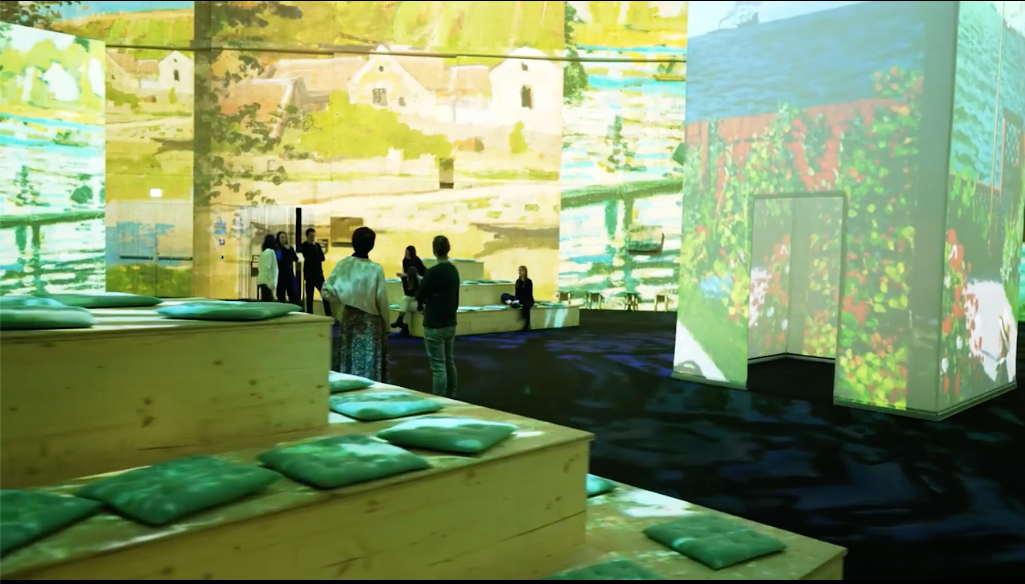
Das Atelier de Lumiere fing vor einigen, vielleicht 3 Jahren damit an, die Bilder der illuminierten, bewegten Malereien von Impressionisten, die auf den Social Media Plattformen wie z.B. Instagram und auf damals noch Facebook heute Meta zu finden waren, sahen umwerfend aus. Haushoch waren die Projektionen und die Impressionisten wurden lebendig. Dieses Format schien Zukunft zu haben und deshalb wurde Monets Garten in der alten Münze in Berlin inszeniert.
An dieser Stelle muss die Autorin von ihrem persönlich Erleben sprechen. Die Werbung auf den Social Media Plattformen versprachen zu durchschreitende Räume, vollständig bespielt mit nahtlosen Projektionen. Das war die Werbung. In der Alten Münze war davon aber nicht ganz so viel zu sehen.
Es gab einen großen Raum mit einer 180 Grad Projektion. Dort fand eine Art animierte Kinovorstellung statt. Das Leben von Claude Monet wurde für ein Publikum, das Claude Monets Werk und Schaffen nicht kannte, erklärt. Die einigermaßen simples Animationen waren eher enttäuschend. Auf dem Boden liegen Fat Boys, der Film dauert gut 44 Minuten, ja und manchmal wird der Boden auch bespielt.
Drum herum reihen sind 3 Räumlichkeiten und das Cafe.
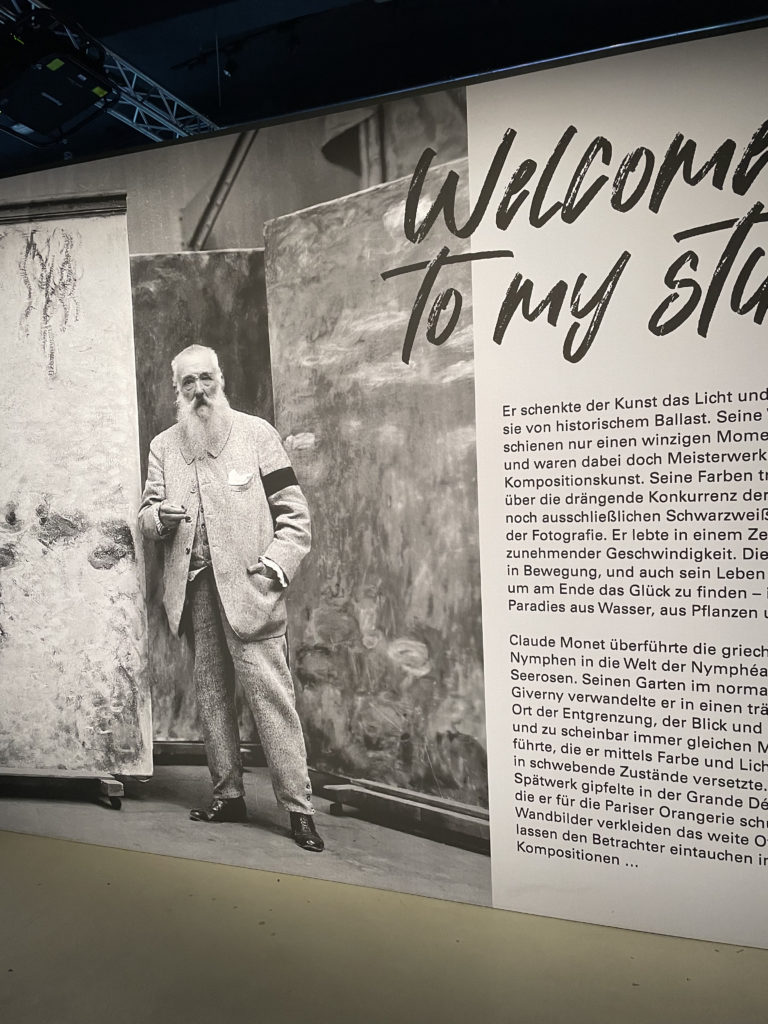
Im Eingangsbereich gibt es eine schriftliche Einführung, dann geht es weiter zu Animationen auf Leinwände. Sie sollen eine großformatige Malerei abbilden und während das bewegte Motiv gezeigt wird, löst es sich auf und wird zu vielen Pixeln. Es ist eine Art Schwarmanimation, schön anzusehen. Das wiederholt sich einige Male.
Eine andere Animation erzählt von der Entstehung von Monets Seerosen. Auch recht nett inszeniert, aber mit Verlaub, da ist Raum noch oben. Vor allem weil die raumgreifenden Bespielungen nicht zu finden sind.
Dann geht es weiter in Richtung Cafe. Die inszenierende Leistung steht im Vordergrund. Mit viel Requisite wird die Brücke über seinen Seerosenteich in Szene gesetzt. Dort finden rudimentäre eher abstrakte Bodenprojektionen statt. Das Leben im Teich wird wohl abgebildet. Die Beleuchtung stimmt, es ist kompakt und auch sehr Instagramabel. Das Cafe selbst ist ein Raum im Raum. Die Fassade soll die Fassade seines Landsitzes in Giverny assoziieren.
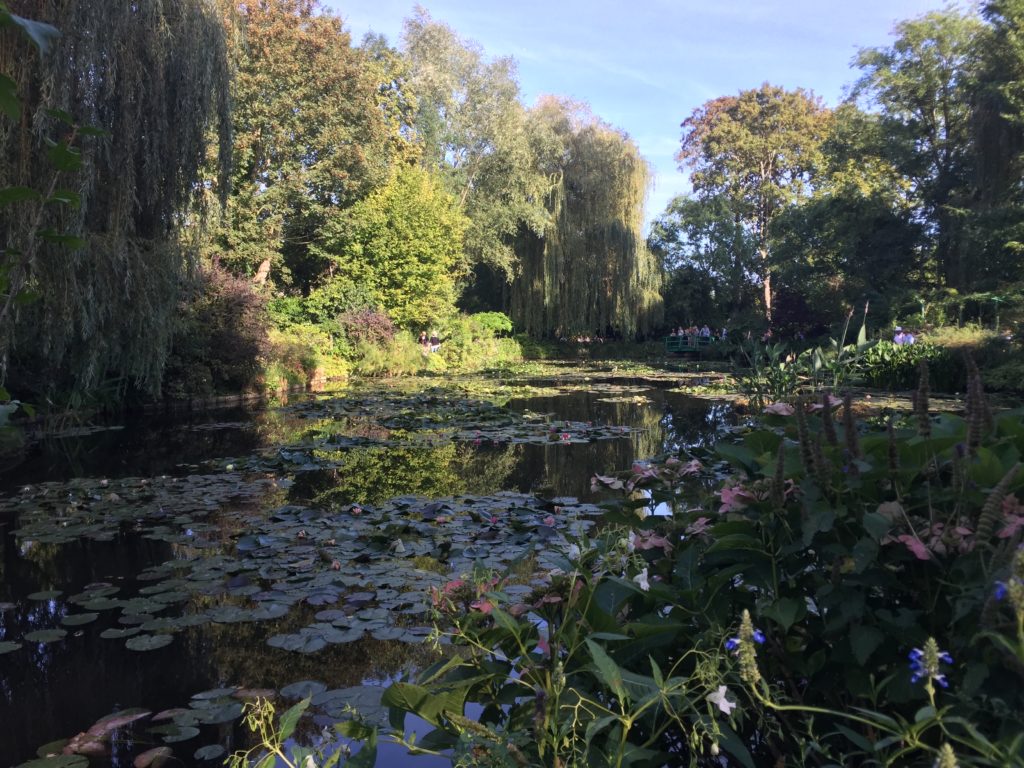
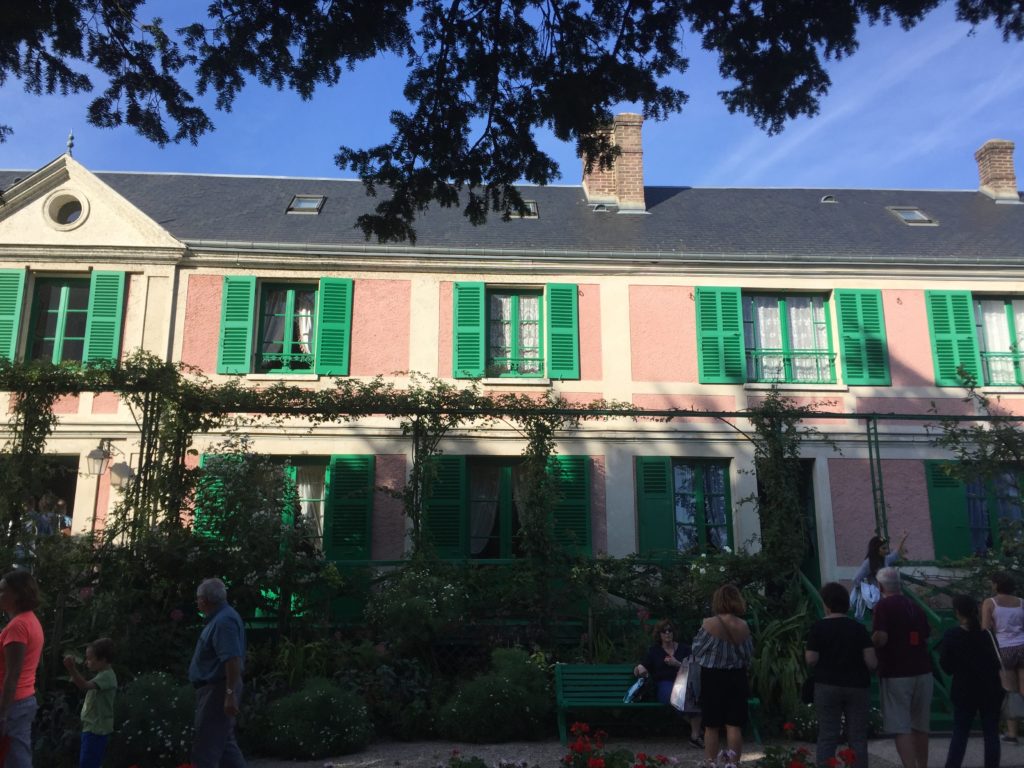
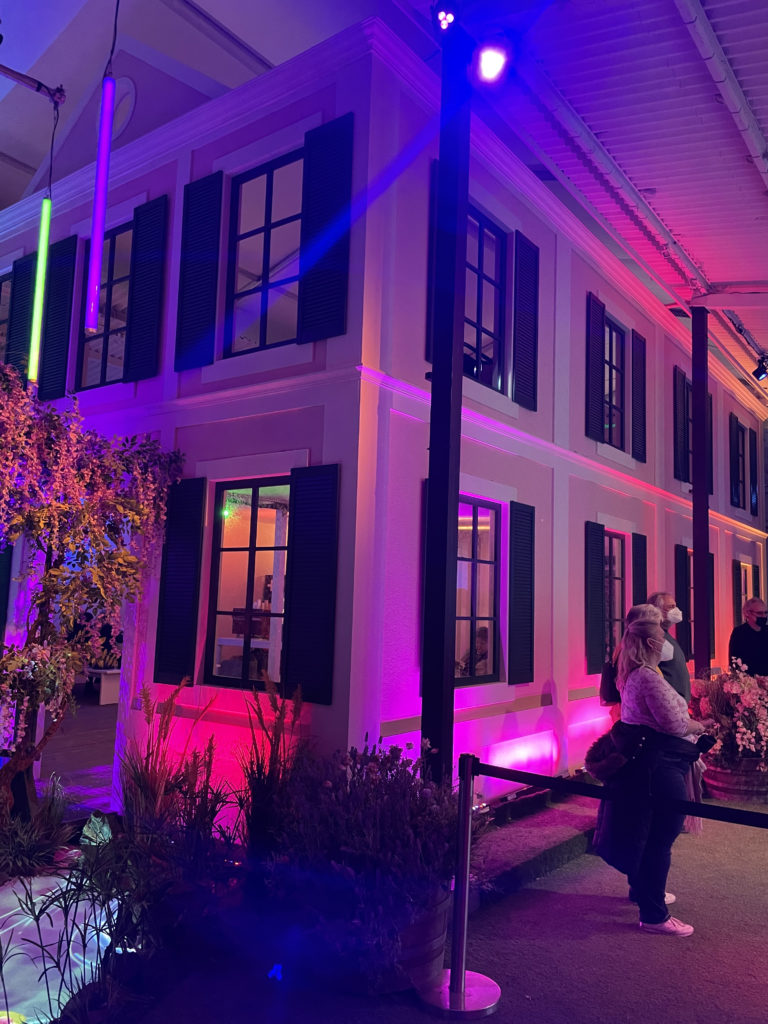
Ein bisschen Klassizismus, aber die Farben der verkleinerten und gestauchten Außen-Fassade sind nicht aufgenommen. Dass die Größe des Landsitzes nicht erfasst werden kann, leuchtet ein, aber die Imitation der Farben, das wäre doch drin gewesen. Der Innenraum ist dann eher ein Cafe, in grau gehalten und irgendwelchen Stühlen und Tischen.
Dann geht’s in der Projektions-Kinoraum. Und auf dem Weg zurück gibt es noch eine Leinwand mit Interaktion über Gestenerkennung. Mit den Bewegungen werden die Partikelanimationen verschoben. Das ist auch nicht gerade sehr innovativ. Kinder mochten es trotzdem.
Wenn Kunst in der Zukunft in dieser Art vermittelt wird, dann darf etwas in die Tiefe gegangen werden. Es ist schön, wenn auf der Ebene der Unterhaltung vermittelt wird, aber das Publikum darf auch mehr eingebunden und gefordert werden. Inhaltlich als auch interaktiv. Denn sonst ist es ziemlich schnell langweilig und enttäuschend. 20€ ist das nicht wert.
http://www.die-inszenierte-abtei.de/
Es geht um die Entwicklung einer ganzheitlich erlebbaren Inszenierung des Innenraums und der Fassade der Abteikirche Otterberg.
Im Inneren findet eine Modeinszenierung statt. Zeitgemäße Fragestellungen zum Thema Mode werden aufgegriffen, Stichpunkte sind: Selbstinszenierung, Social Media / Influencer, Konsum und Reizüberflutung. Der Laufsteg wird mit Projektion, Licht und Sound auditiv-visuell in Bezug zur Architektur gesetzt.
Nach der Show wird die Fassade mit Projektion Mapping bespielt. Thematisch solle es einen fiktiven Blick in die Zukunft unserer Gesellschaft und Umwelt zeigen: Was würde man erzählen, wenn man die Zukunft schon gesehen hat?
Die Herausforderung besteht in der Verknüpfung aktuell gesellschaftlich relevanter Fragestellungen mit der historisch-architektonischen Besonderheit einer über 800 Jahre alten romanischen Abtei (zweitgrößter Kirchenbau der Pfalz).
Das Alleinstellungsmerkmal bestand in der Inszenierung von Mode sowie der visuellen Bespielung eines Sakralraums. Dabei gelang konzeptionell die Verbindung zwischen soziokulturellen Themen wie Religion, Mode, sozialen Netzwerken bis hin zu Konsum und dessen Auswirkungen auf unsere Umwelt, Gesellschaft und Zukunft.
Die große Aufgabe an die Studierenden bestand dabei in der interdisziplinären Kombination medialer Ausdrucksformen – Licht, Projektion, Musik, Mode, Performance – mit der bestehenden Architektur.
Wie ist das Projekt beschrieben
Visuelle Bespielung der vorhandenen Architektur mittels Projection Mapping, Licht, Sound und Performance. Dabei mussten eine Vielzahl an Projektoren, Lichtern und Soundeffekten miteinander kombiniert und synchronisiert werden. Die komplette visuelle und auditive Inszenierung musste in Abstimmung mit der Live-Performance (Laufsteg) konzipiert und umgesetzt werden.
Alle Inhalte, von Animationen über Tanz bis zur Komposition des Soundtracks, sowie die technische Umsetzung wurden eigenständig, in Zusammenarbeit mit Professoren und Lehrbeauftragten, von den Studierenden erstellt.
Die Veranstaltung wurde von den insgesamt über 3000 Besuchern durchweg sehr positiv rezipiert und fand überregionale Aufmerksamkeit und Anerkennung.
Ermöglicht wurde das Projekt durch finanzielle Unterstützung regionaler Sponsoren, sowie durch umfangreiche staatliche Förderungen.
Das Projekt wurde 2019
in INTERDISZIPLINÄRE PROJEKTE, LICHTPLANUNG gezeigt.
Es waren nicht wenige Studierenden, Fachbereiche und Fakultäten beteiligt: Jessica Avarello, Loretta Müller, Melissa Yau, Raphael Katzenmaier, Dominic Wyatt-Rau, Virginia Scholz, Michael Wetzelt, Laura Becker, Mareike Müller, Tanarat Boonsut, Maike Bramer, Adrian Hofmann, Alina Braun, Chi-My Bui, Constanze Littig, Tamara Heitmann, Oliver Stock, Philipp Ledulé, Albane Hundevad, Alicia Mundle, Angelina van Zwamen, Hanna Loos, Johannes Steinle, Jonas Wilhelm, Nicola Andrea Herr, Paula Ziersch, Silvia Wilhelm, Xenia Jochum, Tommy Dombrowski, Jonas Konrad, Alicia Barabasch, Ella Phillippi, Friederike Bischoff, Marta Hupfauer
Supervised by Patrick André Thomas Beisiegel Prof. Holger Deuter Prof. Werner Glas Prof. Matthias Pfaff Dipl.-Des. Verena Potthoff Prof. Christian Schmachtenberg Dipl.-Ing. Nicole Ulrich Prof. Thomas Wagner
Special thanks to Patrick André (Sounddesign, Komposition, Live-Musik), Patrick André, David König, Jonathan König (Live-Musik), Bernd Oswald (Technische Unterstützung)
Förderung
BMBF-Förderungen | FIS – Förderungen individueller Studienwege durch das Referat Studienverlaufsberatung und Tutorien sowie Innovative Hochschule
Förderung beider Veranstaltungen im europäischen Programm (Leader) für:Einzelprojekte im Rahmen des Vorhabens „Ehrenamtliche Bürgerprojekte“ der Landesarbeitsgruppe Donnersberger und Lautrer Land

Die Produktion befasst sich anlässlich des 100jährigen Jubiläums des Bauhauses mit einer Neuinterpretation des Triadischen Balletts von Oskar Schlemmer in Form eines interaktiven Clubs. Nicht nur die Träume von Oskar Schlemmer nach elektronischer Musik sollen in Erfüllung gehen, sondern auch ein Triadisches Ballett, das stetig tanzt.
Die Hochschule der Medien im Studiengang Audiovisuelle Medien hat dazu in der Staatsgalerie Stuttgart, kurz vor dem Lockdown am 14. Februar 2020 eine einmalige interaktive Clubnight in Szene gesetzt. Mit 1770 verkauften Karten waren die Räume der Sterling Halle gut gefüllt. Clubber tanzten mit den virtuellen triadischen Tänzern gemeinsam durch die Nacht.
Die Produktion wurde mit einer Anerkennung ausgezeichnet. Herzlichen Glückwunsch. Die Konkurrenz war international und vielzahlig- und fältig. Keine einfache Aufgabe sich in diesem Bewerberreigen durchzusetzen.
Ermöglicht wurde dieser Wettbewerb durch die großzügige Unterstützung der Karl Schlecht Stiftung.
Beitrag von Ursula Drees

